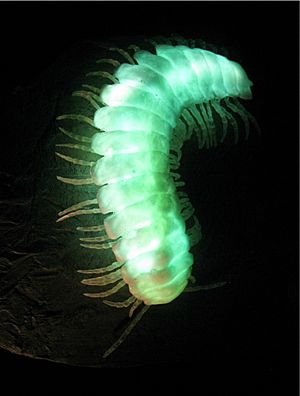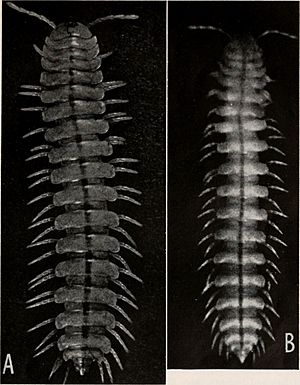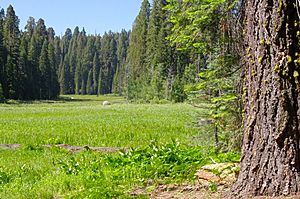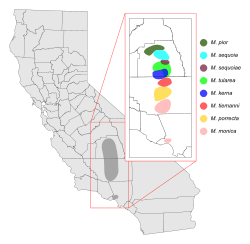Motyxia facts for kids
Quick facts for kids Motyxia |
|
|---|---|
 |
|
| A replica Motyxia at the American Museum of Natural History | |
| Scientific classification | |
| Kingdom: | |
| Phylum: | |
| Subphylum: | |
| Class: | |
| Order: |
Polydesmida
|
| Family: |
Xystodesmidae
|
| Genus: |
Motyxia
Chamberlin, 1941
|
| Type species | |
| Motyxia kerna Chamberlin, 1941
|
|
| Species | |
|
M. bistipita |
|
| Synonyms | |
|
Amplocheir Chamberlin, 1949 |
|
Motyxia are special types of millipedes. They are also called Sierra luminous millipedes because they glow! You can find them only in certain mountain ranges in California, like the Sierra Nevada, Tehachapi Mountains, and Santa Monica Mountains. These millipedes are blind, meaning they can't see.
Like other millipedes in their group, Motyxia can produce a poison called cyanide. What makes them truly unique is their ability to glow brightly. This is a rare superpower among millipedes, known as bioluminescence.
Contents
What Do Motyxia Millipedes Look Like?
Adult Motyxia millipedes are usually about 3 to 4 centimeters (1.2 to 1.6 inches) long. They are also about 4.5 to 8 millimeters wide. Each millipede has 20 body segments, not counting its head. Female millipedes are a bit larger than males.
Like other "flat-backed" millipedes, they do not have eyes. They have flat, wing-like extensions on their sides called paranota. Their bodies are typically tan to orange-pink. Most have a dark line down their back. One species, M. pior, can be many colors, from dark gray to bright orange.
These millipedes have smooth bodies without many bumps. The first few body segments point towards their head. This is very clear in some species, like M. sequoiae. Under a black light, they glow even more brightly.
How Motyxia Millipedes Glow (Bioluminescence)
There are 9 species and 11 subspecies of Motyxia. They are some of the very few millipedes that can glow. There are about 12,000 known millipede species in the world. Motyxia sequoiae glows the brightest, while Motyxia pior glows the dimmest.
The light comes from the millipede's outer shell, called the exoskeleton. They glow all the time. The light gets brighter if you handle the millipede. All their body parts, like legs and antennae, glow. Their insides do not glow.
This glow is made by a special chemical process in their exoskeleton. It uses a special glowing protein. This is different from how fireflies glow. Scientists are still studying exactly how this glowing protein works.
Why Do Motyxia Millipedes Glow?
For a long time, scientists wondered why Motyxia millipedes glowed. Some thought it was a warning sign to predators at night. Others thought it had no real purpose. Some even thought it might accidentally attract predators.
A study was done in California where Motyxia live. Researchers found that the glow really does scare away animals that hunt at night. Millipedes whose glow was covered with paint were attacked more often. Clay models painted to glow were attacked less than unpainted models. This showed that the glow acts as a warning signal. It tells predators, "Stay away, I'm poisonous!"
One species, M. bistipita, was found to glow in a lab. It lives in hotter, drier areas. Scientists think its glow might first have helped its body deal with heat. Later, this glow became a warning sign to predators about the cyanide poison inside.
Besides Motyxia, only a few other millipedes are known to glow. These include Paraspirobolus lucifugus from Japan and Taiwan, and Salpidobolus.
Where Motyxia Millipedes Live and What They Do
Motyxia millipedes live in forests with live oak trees and giant sequoia trees. They are also found in open meadows. It's unusual for their family of millipedes to live in meadows. Most prefer broad-leaf forests.
Motyxia millipedes are active only at night. During the day, they hide by burrowing under the soil. At night, they come out to find food. They eat decaying plants and other dead plant material. Some species, like M. sequoiae, have been seen climbing trees. They might be eating algae or lichens growing on the bark.
Animals that hunt Motyxia millipedes include rodents, centipedes, and glowworm larvae.
Life Cycle of Motyxia Millipedes
The life cycle of M. sequoiae was studied in the 1950s. Female millipedes lay round eggs, about 0.7 millimeters wide. They lay groups of 70 to 160 eggs at a time.
After about two weeks, tiny larvae hatch from the eggs. They are about 1.7 millimeters long. They have seven body segments and three pairs of legs. Even as babies, these millipedes can glow!
As they grow, they shed their skin in a process called molting. Before each molt, they build a protective ball out of soil. With each molt, they gain more legs and body segments. Young millipedes go through seven stages of growth before they become adults. Male millipedes start to develop their reproductive parts in the fourth stage. After this stage, males have one fewer pair of walking legs than females.
Where Motyxia Millipedes Are Found
Motyxia millipedes live in an area about 280 kilometers (175 miles) long. This area covers three counties in California: Los Angeles County, Kern County, California, and Tulare County, California. They mostly live in the Santa Monica, Tehachapi, and southern Sierra Nevada Mountains.
The species found furthest north is M. pior. It lives as far north as Crystal Cave in Sequoia National Park. The species found furthest south is M. monica. This species has two separate groups: one in southern Kern County and another in the Santa Monica Mountains near Los Angeles.
Most Motyxia species live in their own areas and do not overlap. However, M. tularea can be found in the same areas as M. kerna and M. sequoiae.
Motyxia Species
Here is a list of the different Motyxia species:
| Species | Scientist who named it | Where it lives | Notes |
|---|---|---|---|
| M. bistipita | (Shelley, 1996) | Lower parts of the Sierra Nevada mountains in California | Was first called Xystocheir bistipita |
| M. kerna | Chamberlin, 1941 | Southern Tulare County to northern Kern County | |
| M. monica | Chamberlin, 1944 | Kern County, south of the Kern River, and in the Santa Monica Mountains | |
| M. pior | Chamberlin 1941 | Tulare County, Sequoia National Park | |
| M. porrecta | Causey & Tiemann, 1969 | Kern River Valley | |
| M. sequoia | (Chamberlin, 1941) | East Fork of the Kaweah River, Tulare County | Was first called Xystocheir sequoia. Has two types: M. s. sequoia and M. s. alia. |
| M. sequoiae | (Loomis & Davenport, 1951) | Headwaters of the Tule River (Middle fork), Tulare County | Was first called Luminodesmus sequoiae. |
| M. tiemanni | Causey, 1960 | Northern Kern County | |
| M. tularea | (Chamberlin, 1949) | Central Tulare County to far northern Kern County | Was first called Xystocheir tularea. Has two types: M. t. tularea and M. t. ollae. |
How Motyxia Millipedes Are Classified and Evolved
Scientists believe that new Motyxia species formed because of changes in the Earth. These changes included geological events and a drier climate after the last Ice Age. Rivers also played a role, as they were full when the millipedes were most active. Differences in rainfall and habitats in the mountains also helped create new species.
Motyxia belongs to the family Xystodesmidae. This group includes large and colorful millipedes. M. monica is the southernmost species of this family in western North America. Within the Xystodesmidae family, Motyxia is part of a smaller group called the tribe Xystocheirini. Other millipedes in this tribe, like Anombrocheir, Parcipromus, Wamokia, and Xystocheir, are also found in California.




